Rehearsals, Performances & Recording
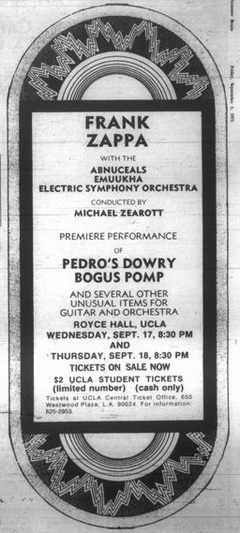
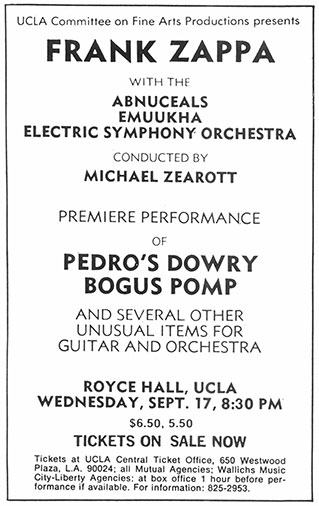
I did this because I wanted to hear my music. Nobody came to me and asked me to put on a concert. [...] The grand total cost is between $50,000 and $70,000, which includes costs like $10,000 just to pay the copyist for making up the scores. Every time we have a full rehearsal of the orchestra, it's about $5,000. It's real lunacy to even be doing this.
[...] You haven't heard anything like this before. One concert will be recorded for an album later on. It's really a tremendous feeling doing this. The only other American composer to put on his own music like this was Charles Ives, and he had made his fortune already in insurance. Something I haven't done.
I happened to get a record from the library by film composer David Raksin recently, and noticed that he mentioned in the liner notes that he had conducted some reading rehearsals of FZ's music prior to the sessions for this record (August 1975). This must have been prep for the Abnuceals concerts.
When I did that performance at UCLA a couple of years ago, the total bill for the copyist was $15,000.00 for 40 pieces.
[Davey] Moire, who met Zappa during the live recordings that went into Bongo Fury (1975), joined the organization when Zappa asked him to mix FOH for the Royce Hall (UCLA) concerts, which resulted in the Orchestral Favorites album (recorded in 1975, but not released until 1979).
Zappa was at the mixer board, mixing the heavily miked 37-piece orchestra.
In 1975 I got a call to do a concert and recording with Frank at UCLA. The orchestra (The "Abnuceals Emuukha Electric Symphony Orchestra") was large and excellent. Frank was on his best behavior and the gig, a few rehearsals, two concerts at Royce Hall and a post concert recording session to "clean up" a few spots, was easy (except for the music) and fun. It got a lot of attention but not as much as the capture of Patty Hearst, which took place the day of the last concert.
Something that really stands out in my memory was when at the end of one of the concerts, Frank "orchestrated" on the spot a two chord vamp, the C# minor to D progression from "Black Napkins," assigning whole notes on various instruments to make the chords. He then brought Bruce Fowler out from the brass section to the front of the stage to do a solo over the orchestra.
Using the financial profits from his surprise hit single "Don't Eat The Yellow Snow," FZ hired an orchestra of roughly 37 pieces to rehearse and perform two evening concerts with afternoon recording sessions. Frank supervised everything, hired sound and lights, mixed the front of house sound at times, conducted the orchestra on occasion, and played guitar with them.
The Musicians
During the summer of 1975, I was hanging with Guru John Bergamo when he said "Hey, I just got this call from Frank Zappa to play percussion along with Emil Richards in a chamber ensemble project Frank's organizing, to be performed at Royce Hall, UCLA. Do you want to come to the rehearsal tomorrow?" Sure I did, thank you John! But I felt casual about it too. I wasn't a fan, I just knew he was great.
The rehearsal was at Frank's studio on Sunset Blvd., a beautiful wood room that could only be accessed from the alley. While the small orchestra was setting up, I decided to stand outside the door in the alley where I could smoke some weed. A minute later, a Rolls Royce stops at the end of the alley, 1/2 a block away from the studio, and out gets Frank Zappa Himself.
[...] Wearing a baggy Hawaiian shirt and decidedly tight stylish jeans with beat up sneakers, Frank looks around, fluffs up his hair to look more disarrayed, lights a cigarette, and lifts a giant folder of music out of the car. Hmmm . . . ok, this is interesting. That's a lot of music. [...] Frank walked up to me, put out his hand, introduced himself, and I returned the gesture, took his handshake and said "Hi Frank. I'm Ed," but nothing else. Frank gave me a warm smile and disappeared into the studio.
[...] He directed the 3 hour rehearsal meticulously. Employees and technicians were everywhere. At the end, a guitar tech walks out to help him into a white hollow body Epiphone guitar, update Frank on the latest mods, Frank plays a few notes, flicks some switches and nods he understands.
"OK, play it again from the top," says Frank. The orchestra starts, and so does Frank. I couldn't have imagined guitar over this music before then, but Frank proceeded to play on top of it all, improvising, and suddenly I heard this composition. Frank's playing was kind of sloppy, but very purposeful, thoughtful and most of all very very musical. "That" I thought "was fucking great." OK, now I'm really starting get this guy (I thought naively.) Wow . . . lots to think about.
With that, Frank brought the rehearsal to an end, dismisses the orchestra, all of whom were top L.A. session players, and some of whom (I later found out) worked for Frank gratis. They just wanted to play interesting and challenging music, and in those days they were making 5-15 kilobucks per week playing TV and film music in the studios, so none of this faction needed any money. In fact, they'd been gathering at Frank's house every Saturday for years, starting up at The Log Cabin, to play Frank's music for him, free. No charge.
Terry Bozzio
Terry Bozzio, "Orchestral Favorites," terrybozzio.com, c. 2002
When I got off the first road tour with Frank in 75 he had organized a concert of his classical music to be played by a 40 piece orchestra of the best players in Los Angeles, at Royce Hall, UCLA. He started by telling me that it would include 4 percussionists who could read and play anything (Emil Richards, John Bergamo, Alan Estes and Tom Rainey), and handed me the music to Bogus Pomp, Pedro's Dowery and Naval Aviation in Art.
[...] This was some difficult stuff and I immediately started to practice it in a little rehearsal room behind Frank's office/rehearsal complex (Intercontinental Absurdities) on Sunset, between Bronson & Van Ness. I decided to play it on my smaller black Gretch kit w/4 toms because it was written for not so many toms. [...]
Then Frank gave me more music from 200 Motels, Gregory Peccary, Uncle Meat, Peaches en Regalia and more. Frank had a precussion section rehearsal (after the first of only a few rehearsals) at Emil Richards "Magic Toy Shop" (a cartage warehouse filled with the most amazing percussion instrument collection I've ever seen!) and was really impressed with my command of his difficult music. After all I had been practicing it on my own and had a good feel for it, where as the others were busy as professional musicians and were more or less sight reading.
[...] The shows demanded classical concentration and presented many ensemble problems with the time and feel but we pulled it off. George Duke came backstage after the show and complimented me on my playing and my press rolls which he said sounded like someone tearing a piece of tissue paper (ie: very smooth)—I was so proud and happy because I felt at last I had gained the respect of not only a great jazz musician who I admired (he was at that time playing with Billy Cobbham), but one of the Zappa veterans that I was so inhibited by when I was first playing with him in the band, and so desperately wanted to be accepted by.
Terry Bozzio, "The Zappa Drummers," Drum Channel, October 2008-March 2009
We did this orchestra music at Royce Hall, we did a couple of nights there and, you saw Emil Richards, Alan Estes, John Bergamo, all the best guys, first call great classical, 40-piece orchestra—Ian [Underwood] was there, playing that big modular Emu synth that he had made.
Lou Anne Neill
I first worked with Frank on a super concert at Royce Hall at UCLA. Then, whenever he needed harp on any of his albums, he'd call me into his studio.
Pamela Goldsmith
It was Jerry Kessler who asked me to join him in a string quartet (electrified) to play with Frank in a giant Royce Hall Concert. It was the first time I had dealt with a pickup (Barcus Berry in those days) and amp (giant Benson amp), so in combination with dealing with Frank I remember being extremely pressurized. I had feedback all the time, as I remember. I used a combination volume control and wah-wah pedal, and once I was fooling around with it during rehearsal and tried using it to produce 'vibrato'. Frank came running out wild-eyed saying 'that's it—you have to use that'. So I did. I played barefoot because that was the only way I could feel the pedal underneath my foot [...]. In the performance, Frank had the string quartet right in front at the edge of the stage, dressed in formal orchestral attire. Except for my bare feet.
[...] Somewhere in the concert Frank came to the mike and announced to the audience, "You think I am a wonderful composer, but the truth is these musicians could improvise their own piece and it would be just as interesting, so let's have them do it now. Let's start with Pam." Then he turned around and gestured to me. Can you imagine the terror that sprung into me at that moment. I picked up my viola and began to improvise, in a very avant-garde, all over the place style (they tell me it sounded a little like ornette coleman). Then he gestured to others to join in, waved people in and out, indicated dynamic changes and so forth. When he cut off the music (noise, whatever), the audience cheered wildly. I could only think: "Thank god that's over—I hope no one ever asks me to improvise in public ever again"!
Malcolm McNab
UCLA Royce Hall with a 37 piece orchestra. Same stage where I met and worked with Aaron Copland. I remember that during the concert Michael Zearott was conducting in white tie and tails and Frank removed his shirt and jumped on the podium dismissing Zearott and took over the baton.
Bill Mays
Fusion was in its heyday then and that led to some noteworthy gigs in that genre: Tom Scott's L.A. Express, Indian electric-violinist Dr. L Subramanian, and Frank Zappa (a large ensemble in which I played clavinet).
Andre Lewis
The first gig was to be a 40-piece orchestra concert at Royce Hall before we started the Mothers tour. He was rehearsing for this and forming the new band at the same time. I didn't think I would be playing on this gig because the music was all read and I was just starting to get adjusted. But he asked me to play the gig anyway, my only duty on the gig was to accompany him on the organ during his solos. He would conduct the orchestra and when he reached for his guitar to play, I would come from behind the curtain and accompany him on the B3.
The Original Project
Six Things
I asked him about his experience playing with orchestras and writing music that incorporated classical stylings.
"I just did another album—Six Things," he replied and jumped up to put on his new orchestral work with enthusiasm. He told me from the other side of the room. "I don't do this kind of music to be part of that scene. Basically the setting disgusts me."
As he placed the record on the phonograph we discussed classical musicians he admires. Some of the composers who he finds exciting are: Ligeti, Penderecki, Messiaen, all extraordinary contemporary musical expressionists. [...] Frank was very interested and then placed the needle on the acetate. I was impressed by the collage of opening sounds and the different qualities. A mixture of serious and fun. I was moved to ask him if he considered himself a genius. "Yeah," he answered with a grin. He told me that he hoped the orchestral album would be released soon and would be enjoyed by his regular audience.
April 5, 1976—Untitled Kendun Recorders Acetate
Rockaway.com Auction, c. October 2007
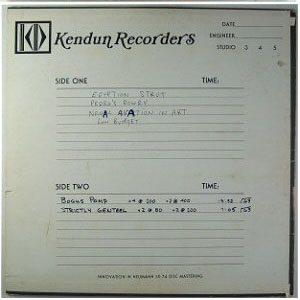
SIDE ONE
EGYPTION STRUT
PEDRO'S DOWRY
NAVAL AVIATION IN ART
LOW BUDGET
SIDE TWO
BOGUS POMP
STRICTLY GENTEEL
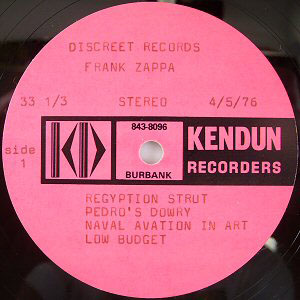
DISCREET RECORDS
FRANK ZAPPA
33 1/3 RPM
STEREO
4/5/76
side 1
REGYPTION STRUT
PEDRO'S DOWRY
NAVAL AVIATION IN ART
LOW BUDGET
April 22, 1976—Six Things (Kendun acetate)
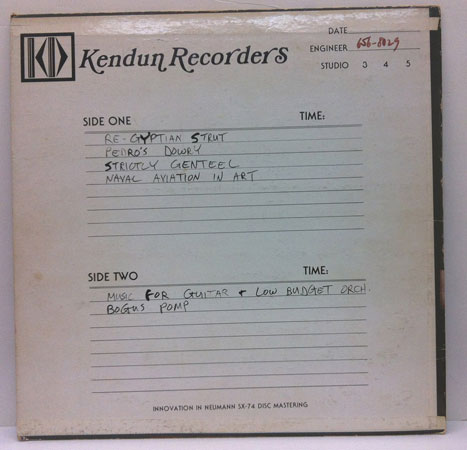
SIDE ONE
RE-GYPTIAN STRUT
PEDRO'S DOWRY
STRICTLY GENTEEL
NAVAL AVIATION IN ART
SIDE TWO
MUSIC FOR GUITAR & LOW BUDGET ORCH
BOGUS POMP
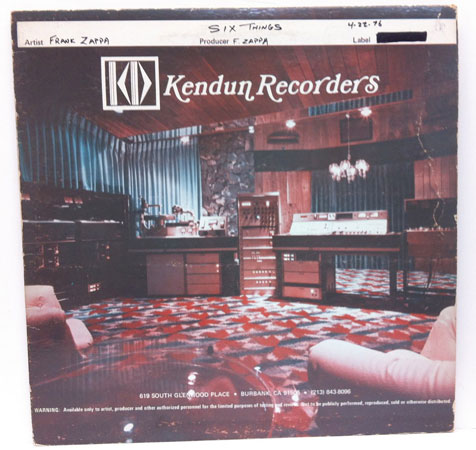
SIX THINGS
4-22-76
Artist FRANK ZAPPA
Producer F. ZAPPA
Label [xxx]
The following songs include the running time on this release next to the running on the official release and they appear to be largely the later released versions (though the xylophone in "Re-Gyptian Strut" does seem a bit more in the forefront than the Ryko version). Side One: Re-Gyptian Strut (4:09 / 4:36), Pedro's Dowry (7:36 / 7:42), Strictly Genteel (6:58 / 7:04), Naval Aviation In Art (1:20 / 1:23). Side Two: Music For Guitar & Low Budget Symphony & Bogus Pomp. These two tracks segue into each other to form one long track, unlike the released versions which appeared on the albums "Studio Tan" and "Orchestral Favorites," respectively (total running time 20:52 versus the 21:05 combined running time of the two tracks).
Reel To Reel Tape (date unknown)
01 Strictly Genteel (totally different take, with differences in orchestration)
02 Duke Of Prunes (no guitar solo; just backing tracks)
03 Black Napkins (from Sep. 18 concert, unreleased)
04 Rollo (longer edit than on QuAUDIOPHILIAc; 42 secs more at the beginning)
05 Pedro's Dowry (possibly differences in mix compared to OF version)
06 Naval Aviation In Art? (no difference to OF version)
[...] Reel-to-reel tape (probably 1st gen)
Columbia Masterworks
[FZ] has completed an orchestral album, but "Columbia Masterworks would'nt agree to my terms," he explained, "so they arent going to get it."
Additional informant: Javier Marcote.
2. Pedro's Dowry
The unusual concert partly grew out of Zappa's longstanding effort to get away for a vacation. "I really needed one and even had a room reserved at a hotel. Then I decided I would do this orchestra thing, so I sat down in my basement workroom and started writing 'Pedro's Dowry.' I was really involved—14 to 18 hours a day, for three weeks. I haven't felt that good in years!
"I told my wife, 'That's the best vacation I ever had!' 'Pedro's Dowry' is wonderful. It may even last as a great piece of music—and this is only the second time I've felt this way about one of my own pieces. It's got some neat things in it."
"Pedro's Dowry" is a ballet. Since a stage production of a ballet would have been too expensive, Zappa read us the storyline: A woman waits at the window for her lover. He arrives with an inexpensive guitar. She puts on some more lipstick. The woman mixes him a stimulating drink. An ashtray is overturned in the midst of their heated love-making.
The orchestra not only plays the complex, constantly evolving score, but also performs the added stage directions such as "brass section waves hankies," "orchestra lights cigarettes during rest," and "lead violin rips off bow tie, tears open shirt, plays blistering three-note solo, bows, and is presented with flowers by harpist."
The presentation is very theatrical and much more interesting than the standard orchestral performance which it parodies. This piece was also conducted by Zearott with Zappa at the mixer. Again here, Zappa quoted from past works such as Lumpy Gravy and 200 Motels. Parts of the romance/ballet were acted out by the viola player who flirted with the trombonist. He responded by suggestively pumping his slide back at her. To celebrate the end of the piece, the entire orchestra whipped out noisemakers and streamers. Zappa made them do it.
"Pedro's Dowry" had a sort of libretto of instruction and direction of scene for the ballet as well as the musicians. A favorite part for me was at the end where the scene states "Within minutes Pedro has cleaned up the room." So in the score electric bassist, Dave Parlato, is instructed to turn on a canister vacuum cleaner and wave the hose around over his head! It's actually a very cool sound blended with Frank's instruction to the orchestra to sing anyting through kazoos!
"Pedro's Dowry—Yes, That's Right"
Millennium Park, Jay Pritzker Pavilion, free
[...] Frank Zappa, Dog Breath Variations/Uncle Meat and Pedro's Dowry: yes, that's right
Correct me if I'm wrong, but it seems like this is the first time the work's subtitle makes it into a public concert program.
FZ himself never made no public mention of it, not even in concert programs. But it's certainly there in the Munchkin Edition score (although not in the "reduction").







